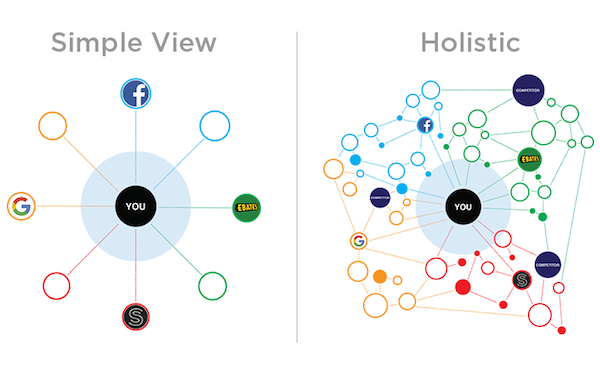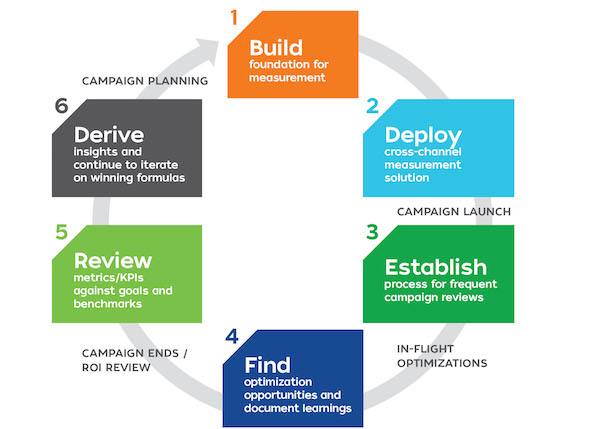The following article is a guest post by Tyler Foxworthy, chief scientist at DemandJump. I loved how this article connects several fields of math to marketing challenges that are being addressed with artificial intelligence. I’ve added several links to Wikipedia pages, if you want to geek out on this like I have.
The field of network science, which is rooted in statistical physics and graph theory, has emerged in recent years to help us understand how complex networks such as the internet form and evolve over time.
Social networks, the financial system, airlines, communication systems, the Internet — these complex networks are the substrate and substance of modern life.
Networks such as the Internet form following a process referred to as preferential attachment, whereby the competitive dynamics of the free market influence the topology of the internet like a glacier cuts a valley through a mountain range.
Preferential attachment is often referred to as “the rich get richer” phenomena — i.e., the more popular a node in a network (e.g., domains, websites, social influencers), the more likely it is that a newcomer to the network will want to link to it.
Over time, preferential attachment results in clustering among related web pages in a way that makes modern search engines possible. Data-driven marketers recognize these clusters as competitive ecosystems. Arguably, the reason Google succeeded, where earlier search engines failed, was due to their innovative understanding of the topology of scale-free networks.
The proliferation of marketing data and rapid advances in hardware allow marketers to map and measure the dynamics of their market ecosystems. The methods of network science allow them to comprehend it.
A holistic, network-level understanding of a marketing ecosystem provides countless benefits for marketers, and, in fact, will alter the course of marketing indefinitely. This represents a critical opportunity for marketers to shift away from last-click attribution and other simplistic models. Today, marketers can identify which nodes (domains, websites, social influencers) are affecting traffic and revenue — multiple steps before customers reach the domains of them or their competitors.
Graph theoretic methods enable savvy marketers to not only construct highly accurate maps of their market, but to track competitors, identify exactly where wins and losses occur, and predict where the greatest revenue opportunities can be captured.
It’s the difference between the first cartographers trying to map the geography of the Earth, and the 2000+ satellites that orbit our planet today. Having a holistic, network-level view, allows us to understand our surroundings with exponential precision.
When coupled with artificial intelligence techniques such as reinforcement learning, these methods lead to strategies that optimize budget allocation and, ultimately, drive revenue.
Harnessing the Power of a Network: Propagation Value
Intuitively, marketers know that connections in a competitive ecosystem are not static. Instead, they fluctuate in response to seasonality, trends, and the marketing effects of one’s competitors, among other factors.
Although significant insights can be obtained from a static connectionist view of the network, these insights become significantly more predictive if we are able to understand how connectivity patterns within competitive ecosystems persist into the future.
Using advanced mathematical techniques (including Markov Chain theory and algebraic topology), it is possible to determine both the direct traffic contributions of a particular web domain and its indirect traffic driving potential within the network the marketer or brand is trying to dominate.
We refer to this indirect (or “pass-through”) traffic as the propagation value of a source. Differences in connectivity and temporal traffic patterns between domains can lead to drastically varying propagation values. This means simply that while two sources might drive the same direct volume of traffic to a website, one of the sources often drives traffic to additional sites in the ecosystem that are of more value to a specific marketer or brand.
The best marketers will seek to understand the direct traffic contribution of each source — as well as the indirect propagation value of the same sources — to uncover the greatest sources of traffic and revenue generation.
The marketer that has visibility to the most powerful direct and indirect sources can anticipate competitive shifts, seize share, and win at the traffic and revenue game.
By prioritizing opportunities in the ecosystem with higher propagation value to them and their competition, marketers will see greater gains in traffic across multiple sites in their ecosystem than selections motivated solely by direct or last-click traffic.
Optimizing Budget Allocation with Artificial Intelligence
The proliferation of marketing channels has resulted in an abundance of media and marketing investment opportunities, along with a glut of data. When coupled with the continuous shift in consumer preferences, trends, seasons, and other variables within an ecosystem, it has become impossible for marketers without sophisticated AI tools to detect, predict, or respond in real time to opportunities or competitive threats.
In marketing, impactful AI implementation comes down to one goal — real-time, actionable results.
While AI is cast in the media as a singular, ominously powerful technology, the reality is that there are many varieties of machine learning algorithms, and each is suited for specific tasks.
In fact, the art of AI is rarely in building the algorithms themselves. Rather, it is in the ability to define problems in such a way that the algorithm can identify patterns and “learn” the best solution, given the data and computational resources available.
In much the same way that self-driving cars have internal models for identifying lanes and other vehicles, temporal network models are able to form a context from which to define the majority of marketing problems and optimize predicted outcomes across a wide array of possible marketing actions.
While marketers can certainly benefit from other well-known varieties of artificial intelligence — such as those devoted to natural language processing or image classification — the future of AI in marketing will be centered around dynamic optimization methods such as reinforcement learning that learn equally well from historical data as well as real time performance.
Reinforcement learning (RL) is a modern artificial intelligence technique that can address problems which are indiscernible by traditional optimization methods. RL is able to continuously adapt itself based on new information, making it ideal for optimization problems embedded within dynamic networks such as budget allocation and display targeting.
Moving Forward
Marketers have much to look forward to from AI in the years to come. Graph theory and algebraic topology are not artificial intelligence. They are the foundation upon which intelligent systems for online markets should be constructed. The environment is a moving target, and multiple competitors, trends, multiple scales, along with incomplete data sets, make these problems especially difficult.
For the next several years, we will likely see more co-pilot type systems, rather than autopilot (“set it and forget it”) systems. Gradually, as scientist learn to build better models for capturing market dynamics, these systems will take on more of the mechanical load of marketers, leaving them time to focus on the more strategic and creative aspects of their jobs.
Thanks, Tyler!





Love the explanation of graph and network propagation. I feel that the graphics might make more sense to me if the topic, rather than my website, was in the middle. It seems as if the gravity of the topic is the thing that shapes the map rather than the website … of course Google should be in the center, because it exerts fundamental pull when people search and then people launch back out to other sources of network gravity.
Tyler – great piece, and a topic that needs to be much more understood by marketers, as it’s about the spontaneous emergence of order out of apparently random signals – in marketing terms. the receiver, not the sender, is in charge, and part of a nonlinear network. I’d encourage folks who like this topic to check out a couple of earlier works in Network Science – Duncan Watts’ book “6 Degrees” and Steve Strogatz’s (Watts was a student of his) great TED talk from, gulp, 2004, about the emergence of sync – https://www.ted.com/talks/steven_strogatz_on_sync . Compelling and genius stuff. And a great guy and legitimate mathematical scientist to boot.